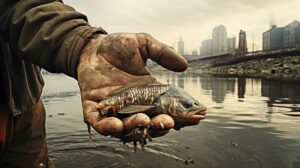Freshwater fish: Panfish

Characterised by their ideal size for frying pan cooking, Panfishs are notable in recreational angling and culinary traditions.
Panfish are typically small, making them a famous catch for anglers of all ages. Their mild, sweet flesh makes them a favourite for cooking, whether pan-fried, grilled, or baked. In addition to their culinary appeal, Panfish are also valued for their role in maintaining the balance of aquatic ecosystems. Their presence helps control insect populations and provides food for larger predatory fish. Panfish are a beloved and vital part of freshwater environments and fishing culture.

What is a Panfish?
Panfish is a term used to describe a category of small freshwater fish typically caught for recreational fishing and are also popular in cuisine. These fish are known for their size, making them perfect for cooking in a frying pan, hence the name “panfish.”
Characteristics of Panfish
Panfish are generally smaller, making them ideal for anglers looking for a fun and rewarding fishing experience. They are often colourful and can be easily identified by their distinctive markings and patterns.
Popular Species of Panfish
The most popular panfish species include Bleak, Roach, Perch and Eurasian Rudd. These fish are widely distributed across Europe and are highly sought after by anglers for their abundance and delicious taste.
Habitat and Behavior of Panfish
Preferred Habitats of Panfish
Panfish fish are commonly found in shallow waters of lakes, ponds, rivers, and streams. They prefer areas with plenty of vegetation and cover, providing protection and a steady food supply.
Feeding Behavior and Diet
Panfish are omnivorous and feed on aquatic insects, small crustaceans, and plant matter. Their diverse diet makes them relatively easy to catch using a variety of bait and lures.
Reproduction and Spawning Habits
Panfish typically spawn in the spring when water temperatures rise. They build nests in shallow waters and lay their eggs, which the males fertilise. This reproductive behaviour makes them vulnerable to overfishing during the spawning season.

Example of a Panfish: the Roach (Rutilus rutilus)
The Roach is a popular fish species found in Europe and Asia. It is known for its silvery appearance and is prized by anglers for its fighting spirit when caught.
The Borderline Between Panfish and Other Fish Types
Why is the Classification Not So Easy?
The classification of panfish can be challenging due to the diverse characteristics of these fish. While they are generally small and found in freshwater, some species may exhibit predatory behaviour or have feeding habits that overlap with other fish types.

The Perch: Panfish or Predatory Fish?
The Perch is often considered a panfish due to its small size and popularity among anglers. However, it also exhibits predatory behaviour, preying on smaller fish and aquatic organisms, blurring the line between panfish and predatory fish.
Young Breams: Panfish or Bottom Feeders?

Young breams are often classified as panfish due to their small size and popularity in recreational fishing. However, as they mature, they tend to become bottom feeders, consuming a diet that includes small invertebrates and algae, which differs from typical panfish feeding habits.
Panfish Fishing Techniques and Gear
What is Panfish Fishing?
Panfish fishing refers to catching smaller fish like Perch, Roach, and Bleak for recreational and culinary purposes. Anglers often use lightweight tackle and small lures or bait to attract and catch these fish.
Panfish fishing can be enjoyed from the shore, a boat, or even through ice fishing in colder climates. Anglers may also use fly or float fishing techniques to target panfish in different water conditions. Understanding the habits and habitats of panfish is essential for successful fishing, and many anglers enjoy the challenge and reward of catching these beloved freshwater species.
Best Techniques to Catch Panfish
Panfish can be caught using various techniques, mainly spot fishing, fly fishing, and small jigs or spinners. They are known for their willingness to bite, making them an excellent target for novice anglers.
Essential Gear for Panfish Fishing
Anglers targeting panfish typically use light tackle, such as ultralight rods and reels, to enhance the excitement of catching these small but aggressive fish. Small hooks, floatss, and various artificial baits are also commonly used.
Tips for Successful Panfish Angling
When targeting panfish, it is essential to focus on areas with abundant vegetation and cover, as these are prime feeding and spawning grounds for these fish. Additionally, using small, natural-looking baits and lures can increase the chances of a successful catch.
Panfish as live baits for Predatory fish
Panfish are often used as live bait for predatory fish such as Bass, Pike, and Zander. Their small size and lively movement make them irresistible to larger predatory species, making them an excellent choice for anglers targeting these types of fish. However, checking local regulations and restrictions regarding using live bait is essential, as some areas may have specific rules to protect native fish populations. When using panfish as live bait, anglers should also consider the ethical implications and ensure that they follow sustainable fishing practices to preserve the balance of the ecosystem.
Culinary Delights
The Taste and Texture of Panfish
Panfish are known for their delicate and mild flavour, making them a favourite among seafood enthusiasts. Their flesh is often tender and flaky, lending to various cooking methods.

Popular Recipes for Cooking Panfish
There are numerous ways to cook Panfish, including frying, grilling, baking, and even in soups and stews. Popular recipes include Gudgeon omelette, fried Minnow, and grilled Perch.
Tips for Preparing and Serving Panfish Dishes
When preparing panfish, it is essential to keep the flavours simple to allow the fish’s natural taste to shine through. Light seasoning with herbs, lemon, and a side of fresh vegetables often complements the delicate flavour of panfish.
Conservation and Sustainable Fishing Practices
Importance of Conservation for Panfish Populations
Maintaining healthy panfish populations is crucial for preserving the balance of freshwater ecosystems. Overfishing and habitat destruction can lead to a decline in panfish numbers, impacting the environment and recreational fishing opportunities.
Sustainable Fishing Practices for Panfish
Practising catch-and-release, adhering to fishing regulations, and avoiding overexploitation of panfish populations are essential for sustainable fishing. Additionally, supporting habitat restoration and conservation efforts can contribute to the long-term health of panfish populations.
Balancing the Enjoyment of Fishing with Environmental Responsibility
As fishing enthusiasts, it is essential to enjoy the sport responsibly and consider the impact of our actions on the environment. By practising ethical angling and supporting conservation initiatives, we can ensure that future generations can continue to enjoy the thrill of catching and savouring these beloved freshwater fish.






